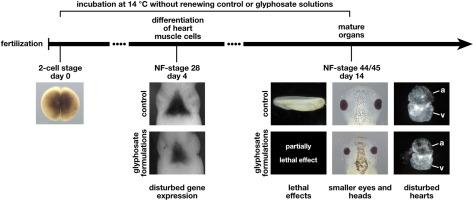Glyphosate formulations cause mortality and diverse sublethal defects during embryonic development of the amphibian Xenopus laevis
IF 8.1
2区 环境科学与生态学
Q1 ENVIRONMENTAL SCIENCES
引用次数: 0
Abstract
The human impact on environmental landscapes, such as land use, climate change or pollution, is threatening global biodiversity and ecosystems maintenance. Pesticides like the herbicide glyphosate have garnered considerable attention due to their well-documented harmful effects on non-target species. During application, the active ingredient glyphosate is utilized in various formulations, each containing different additive adjuvants. However, the possible effects of these formulations on amphibians - the group with the highest decline rates among vertebrates - remain largely unknown.
Therefore, the present study investigated the effects of four glyphosate formulations (Glyphosat TF, Durano TF, Helosate 450 TF, Kyleo) on the embryonic development of the model organism Xenopus laevis (South African clawed frog). Embryos at the 2-cell stage were exposed to various concentrations of glyphosate formulations (glyphosate: 0.01–100 mg/L), and mortality as well as sublethal effects on different organs and tissues were analyzed. The results indicated that the formulations had different effects, particularly on the mortality of Xenopus laevis embryos. At sublethal concentrations, the formulations altered the embryos' external appearance, leading to malformations such as reduced eye and head size. In addition, exposure to formulations impaired heart morphology and function, and the expression of heart-specific genes was altered at a molecular level.
Our results confirmed that glyphosate formulations had a stronger effect on Xenopus laevis embryogenesis than pure glyphosate. Therefore, it is crucial to evaluate the active ingredient and the co-formulations independently, as well as the combined, commercially available products, during pesticide risk assessments and renewal procedures of agrochemicals. The severe global decline of amphibians, partly due to herbicide use, highlights the need for strict and efficient monitoring of environmental pesticide loads and application areas.

草甘膦制剂会导致两栖动物 Xenopus laevis 胚胎发育过程中的死亡和多种亚致死缺陷。
人类对环境景观的影响,如土地使用、气候变化或污染,正在威胁着全球生物多样性和生态系统的维护。除草剂草甘膦等杀虫剂因其对非目标物种的有害影响而备受关注。在施用过程中,活性成分草甘膦被用于各种配方中,每种配方都含有不同的添加佐剂。然而,这些制剂对两栖动物--脊椎动物中衰退率最高的类群--可能产生的影响在很大程度上仍然未知。因此,本研究调查了四种草甘膦制剂(Glyphosat TF、Durano TF、Helosate 450 TF 和 Kyleo)对模式生物爪蛙(南非爪蛙)胚胎发育的影响。将处于 2 细胞阶段的胚胎暴露于不同浓度的草甘膦制剂(草甘膦:0.01 - 100 毫克/升)中,分析其死亡率以及对不同器官和组织的亚致死效应。结果表明,这些制剂具有不同的影响,特别是对爪蟾胚胎的死亡率的影响。在亚致死浓度下,制剂会改变胚胎的外观,导致畸形,如眼睛和头部缩小。此外,接触草甘膦制剂还会损害心脏的形态和功能,并在分子水平上改变心脏特异基因的表达。我们的研究结果证实,草甘膦制剂比纯草甘膦对爪蟾胚胎发育的影响更大。因此,在农药风险评估和农用化学品更新程序中,对活性成分和共同制剂以及市售组合产品进行独立评估至关重要。两栖动物在全球范围内的严重减少,部分原因是除草剂的使用,这凸显了对环境农药负荷和施用区域进行严格有效监测的必要性。
本文章由计算机程序翻译,如有差异,请以英文原文为准。
求助全文
约1分钟内获得全文
求助全文
来源期刊

Chemosphere
环境科学-环境科学
CiteScore
15.80
自引率
8.00%
发文量
4975
审稿时长
3.4 months
期刊介绍:
Chemosphere, being an international multidisciplinary journal, is dedicated to publishing original communications and review articles on chemicals in the environment. The scope covers a wide range of topics, including the identification, quantification, behavior, fate, toxicology, treatment, and remediation of chemicals in the bio-, hydro-, litho-, and atmosphere, ensuring the broad dissemination of research in this field.
 求助内容:
求助内容: 应助结果提醒方式:
应助结果提醒方式:


